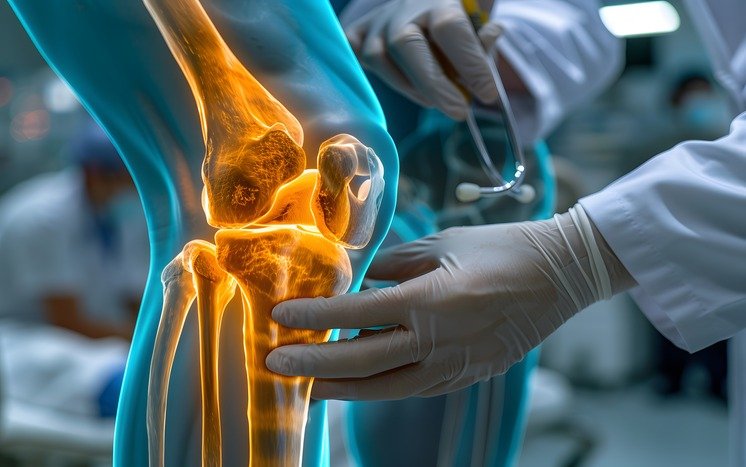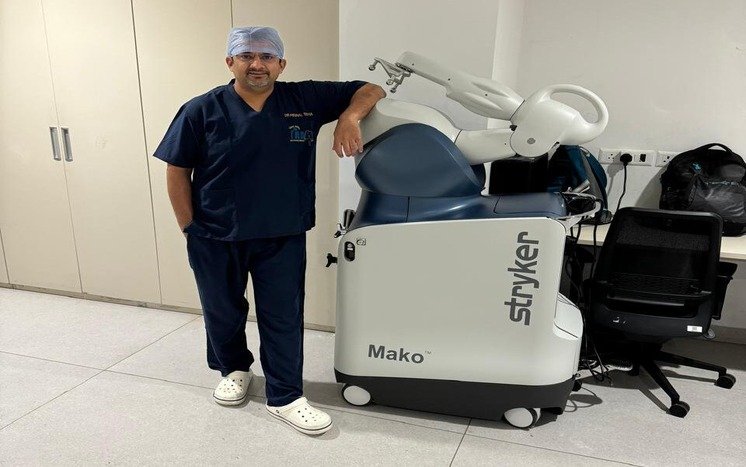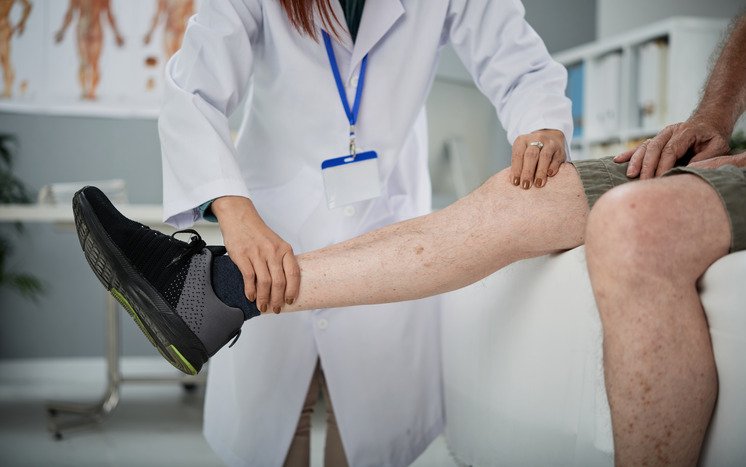
10:00am to 04:00pm (Mon to Sat) - Amrita Hospital, Faridabad
06:00pm to 08:00pm (Mon to Sat) - Arthrocare Clinic, Noida
10:00am to 04:00pm (Mon to Sat) - Amrita Hospital, Faridabad
06:00pm to 08:00pm (Mon to Sat) - Arthrocare Clinic, Noida
 November 4, 2024
November 4, 2024
Robotic-assisted knee replacement has transformed orthopedic surgery, offering advanced tools that support precision, consistency, and potentially improved outcomes. However, with these innovations come several myths and misconceptions that may leave patients feeling uncertain. This blog will break down common myths about robotic-assisted knee replacements, addressing concerns around accuracy, safety, cost, invasiveness, and surgical outcomes. Let’s separate fact from fiction and explore the science behind robotic-assisted surgeries.
Fact: Robotic-assisted knee replacement surgeries are actually designed to improve surgical accuracy.
The robotic systems used in knee replacements, such as the Mako system, provide surgeons with detailed 3D imaging, enabling them to visualize the knee joint in high resolution. With this enhanced view, surgeons can make precise cuts and align implants more accurately than with conventional tools. The robotic arm doesn’t perform the surgery independently. Instead, it guides the surgeon’s movements, allowing for adjustments based on the patient’s unique anatomy.
Supporting Evidence: A study in The Journal of Arthroplasty found that patients who underwent robotic-assisted knee replacement had more accurate implant positioning and better alignment than those who received traditional surgery. This precision has been linked to lower revision rates, suggesting that robotic assistance supports both accuracy and long-term outcomes.
Fact: Robotic-assisted knee replacements are as safe as—if not safer than—traditional procedures.
The robotic systems used in knee replacement surgeries are rigorously tested and FDA-approved, meeting stringent safety standards. These systems aid surgeons by minimizing human error and allowing for precise, controlled movements. Additionally, robotic systems are designed with real-time feedback, helping surgeons avoid unnecessary damage to surrounding tissue. Safety is further enhanced by the fact that the surgeon remains in complete control throughout the procedure.
Supporting Evidence: Multiple clinical studies support the safety of robotic-assisted knee replacements. Research published in Clinical Orthopaedics and Related Research reported that robotic-assisted knee replacements resulted in fewer complications compared to traditional surgery. These findings underscore the safety of robotic systems, making them a viable option for patients concerned about surgical risks.
Fact: Robotic-assisted knee replacements may have a higher upfront cost, but they can reduce long-term expenses.
While it’s true that robotic-assisted procedures may be more expensive due to the technology involved, they can lead to cost savings over time. The precision of robotic systems contributes to better implant alignment, which can extend the lifespan of the implant. This reduces the likelihood of needing revision surgery, a procedure that often incurs significant medical and recovery costs.
Many insurance providers are beginning to recognize the long-term benefits of robotic-assisted knee replacements and may cover a portion of the costs. It’s worth discussing options with your provider if cost is a primary concern.
Supporting Evidence: According to research in Orthopaedic Proceedings, patients who underwent robotic-assisted knee replacements had lower rates of readmission and revision surgeries. This study emphasizes that the initial cost can be offset by the reduced need for follow-up procedures, helping patients save in the long run.
Fact: Robotic-assisted knee replacement surgery is typically less invasive than traditional methods.
Robotic-assisted knee replacement is often considered less invasive because it allows for smaller incisions and more precise cuts. The robotic system provides the surgeon with a highly detailed map of the knee’s anatomy, allowing for a personalized surgical approach that minimizes damage to surrounding tissue. With smaller incisions and less tissue trauma, patients often experience faster recovery and less postoperative pain.
Supporting Evidence: Studies have shown that patients undergoing robotic-assisted knee replacements experience reduced blood loss and less soft tissue disruption. For instance, research in The Journal of Bone & Joint Surgery highlights that patients who had robotic-assisted surgery generally experienced shorter hospital stays, which is often an indicator of a less invasive procedure.
Fact: Robotic-assisted knee replacements often result in better outcomes for many patients.
Outcomes from robotic-assisted knee replacements are consistently positive. The precision enabled by robotic systems helps achieve optimal implant positioning, which is essential for joint stability, alignment, and overall function. Patients who receive robotic-assisted knee replacements tend to report higher satisfaction levels and experience less pain during the recovery process. The greater accuracy in implant placement also contributes to a more natural joint feel and function, leading to a better quality of life.
Supporting Evidence: A study published in The Bone & Joint Journal found that patients receiving robotic-assisted knee replacements were more satisfied with their surgery results than those who had traditional procedures. Furthermore, the accuracy provided by robotic systems was associated with improved implant longevity, adding to patient satisfaction over the long term.
If you’re considering robotic-assisted knee replacement, Dr. Mrinal Sharma is a highly regarded orthopedic surgeon in Faridabad, known for his expertise in robotic knee replacement. Recognized as one of the best robotic knee replacement surgeons in the area, Dr. Mrinal Sharma combines years of specialized training with advanced technology to ensure precise, effective, and patient-centered care. Under his guidance, patients benefit from the latest advancements in robotic surgery, leading to improved outcomes, reduced recovery times, and enhanced overall patient satisfaction.
Summary
Robotic-assisted knee replacements bring many advantages to the surgical process, countering common myths with substantial evidence. By enhancing accuracy, improving safety, and supporting less invasive approaches, robotic systems like Mako are helping surgeons provide effective knee replacement options. Although robotic-assisted surgeries may have a higher initial cost, they can ultimately lead to better patient outcomes and cost savings over time.
For those considering knee replacement surgery, robotic-assisted options offer promising results backed by science and extensive clinical data. Discussing your specific needs with a skilled orthopedic surgeon like Dr. Mrinal Sharma can help you make an informed decision about whether robotic-assisted knee replacement is right for you.





© 2024 Dr. Mrinal Sharma | All rights reserved. Designed and Developed by DigiTrend